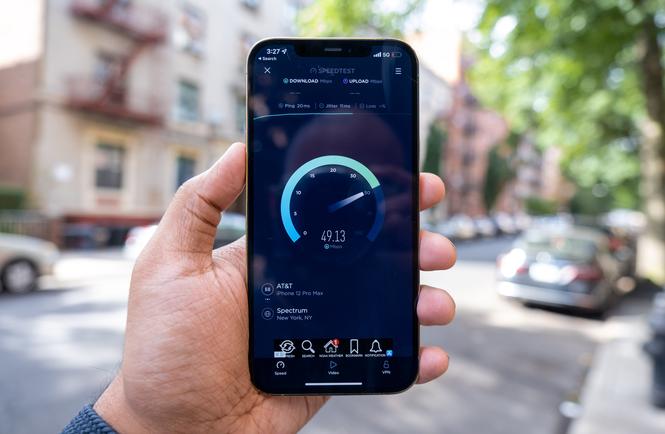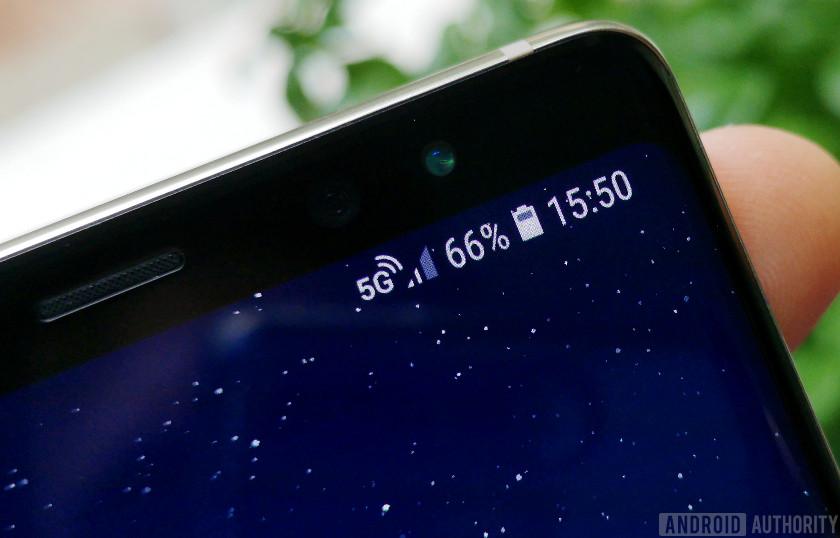
5G is a little better than before, but don’t rush to upgrade your phone just yet.
Gobs of shiny new phones. Massive ad campaigns. A high-profile merger. All of these factors probably propelled the cellular service known as 5G onto your radar this year.
Introducing Help Desk: Technology coverage that makes tech work for you ArrowRightWith the launch of Apple’s newest smartphones — the iPhone 13 series — the big question is back. Is it worth buying a new phone just to get 5G?
Wireless carriers like AT&T, T-Mobile and Verizon all have high hopes for 5G: They claim it will allow more mobile devices to connect than ever before, at faster speeds than what’s available over 4G networks now.
But when we tested those 5G networks in 2020, those faster data speeds were hard to come by. To see how far things have come in a year, my colleague Geoffrey A. Fowler and I set out on a network-testing spree, running hundreds of speed tests from our neighborhoods in San Francisco and New York. Over the last few weeks, we’ve found that these networks have become generally faster than the 4G service you’re used to, but not always by very much.
Don’t just take our word for it: data from the network research firm Opensignal suggests that people’s average download speeds on 5G phones — which by nature sometimes run on 4G depending on coverage — haven’t changed much either. (That is, unless those phones run on T-Mobile service.)
AdvertisementStory continues below advertisementAnd even though you might have heard a lot of talk about 5G this year, we’ve also learned that 2022 will probably be when most people actually start to feel a 5G speed boost.
There’s a very good chance your next smartphone will support 5G, and you won’t have to spend tons of money on it either — wireless carriers have started selling thesephones for under $500. But before you make your final decision about buying one, let’s unpack what’s going on with these networks.
For all the hype we saw, 2020 was a transitional year for 5G. T-Mobile had just finished buying Sprint and hadn’t yet fully combined both networks into one. Verizon hadn’t launched its slower, more widely available 5G network yet. What it did have was a high-speed flavor of 5G called millimeter wave — named for the high frequencies it uses — in a smattering of cities. It’s fast enough to download whole movies in seconds, but its range doesn’t extend for more than a block or two. Meanwhile, AT&T had both of those flavors of 5G up and running but made things confusing by displaying a “5Ge” logo on some of its non-5G phones. In case you were wondering, it is definitely not 5G; it’s pure marketing fluff for its 4G LTE service.
Now, in 2021, all three carriers have nationwide 5G coverage, plus pockets of extremely fast millimeter wave 5G, so they’re about as equal now as they’ve ever been. To get a feel for what a year’s worth of network changes actually means, we spoke to the people who monitor them across the entire country.
For the first six months of this year, network analysis firm RootMetrics had teams of people crisscross the country and perform nearly 3 million 5G speed tests across each of the country’s three major cellphone providers.
After all the number crunching was finished, RootMetrics told us that, nationwide, each wireless carrier’s median 5G download speeds were higher than their 4G speeds. (Median download speed is the one that’s smack in the middle of the full set of results, and it’s helpful for weeding out big variances.) Verizon, AT&T and T-Mobile were just a little higher than last year’s 5G results. It’s an improvement, sure, but not the big step forward most people were probably hoping for.
But this big, nationwide view is just one way to look at 5G. The boundaries of these networks shift frequently, and we wanted to see what 5G can actually offer in different places.
Coverage maps from AT&T, Verizon and T-Mobile all say we live in neighborhoods with the same kinds of 5G service, but does that mean we can expect similar 5G speeds? As it turns out, absolutely not.
Geoff and I both loaded up three iPhone 11s with 4G service from Verizon, T-Mobile and AT&T, and signed up for 5G service from the same carriers for a trio of iPhone 12s. Then, we started running dozens of tests using the Ookla Speedtest app.
AdvertisementStory continues below advertisement
First up: AT&T. In San Francisco, Geoff’s median 5G download speed was about 34megabits per second (Mbps), or about a third as fast as the average U.S. home Internet connection, according to HighSpeedInternet.com. That’s still 41 percent faster than his median 4G download speed, but also exactly as fast as what he saw from AT&T’s 4G network in the Bay Area last year. In Brooklyn, though, my median 5G speed was close to twice as fast as Geoff’s, and about 20 Mbps faster than my 4G result.
What about Verizon? My median 5G download speed landed at 56 Mbps, which was much faster than 4G. But over in California, poor Geoff couldn’t get his iPhone 12 working on Verizon’s 5G at all, despite what Verizon’s coverage map said.
As it turned out, Geoff had his best luck with T-Mobile. The 5G speeds Geoff saw were close to 10 times faster than last year. And second? Even on 4G, his phone was moving data faster than many home Internet connections. My experience wasn’t nearly as good as his; in fact, my median T-Mobile 4G speed was faster than 5G.
So, where does this leave us?
Help Desk: Ask our tech team your questions
Well, despite what coverage maps say, 5G service doesn’t feel equal everywhere — even when you’re using the exact same phone and carrier. And just like RootMetrics, we found 5G to be faster than 4G more often than not, though the download speeds we saw just weren’t all that impressive compared with the average home Internet connection.
According to the experts who built the app we used for our testing, that’s at least partially because of the way most 5G networks are being built.
“If we look at 5G in the U.S., it’s really LTE with some 5G added,” said Doug Suttles, CEO of Ookla.
When I ran tests late at night, when people were less likely to be out, my T-Mobile iPhone 12 pulled down the best speeds of any carrier I tried. To understand why, we need to talk a little bit about how 5G works.
Here’s what you should know: Each of the three major U.S. carriers deliver 5G service through chunks of radio spectrum, which the Federal Communications Commission sells access to. And each of those different chunks fall into a handful of different categories, called “bands.”
Now that Verizon has lit up its nationwide 5G network, all three major U.S. carriers use so-called low-band frequencies to reach a majority of their customers. On the whole, low-band isn’t much faster than 4G LTE, but a single tower can blanket miles with 5G, and those signals are very good at penetrating walls and buildings.
The ugly side of 5G: New cell towers spoil the scenery and crowd people’s homes
On the other end of the spectrum are high-band frequencies that carriers use to deliver speeds that would put your home Internet to shame. Millimeter wave, Verizon Ultra Wideband, AT&T 5G+ — that’s all high band. It’s fantastic, but good luck finding it.
Meanwhile, the stuff in the middle — conveniently called mid-band — seems to be the sweet spot when it comes to improved speeds and distance covered. And right now, thanks to the way it gobbled up Sprint last year, T-Mobile has a lot of mid-band spectrum.
AdvertisementStory continues below advertisement“That’s helped T-Mobile with the speed increases we’ve seen,” said Ian Fogg, vice president of analysis at Opensignal.
So, does that mean AT&T and Verizon customers are just out of luck? In a word: no. Earlier this year, both of those carriers spent billions on new spectrum for 5G, and they’re expected to put them to good use by the end of this year.
“There will be chunks of new capacity coming available,” Fogg said. “That should mean that we’ll see jumps in the 5G experience on all the U.S. carriers from December onwards.”
Here’s our advice: Take a step back and think about what you really need from your phone. If you’re happy with the way it works right now, you still don’t need to rush things.
“If your service right now seems just fine, if LTE is working for you and it gets the job done, you’re probably not going to benefit that greatly,” Suttles from Ookla said of switching to a 5G phone.
But that doesn’t mean you shouldn’t consider upgrading your phone at all. Maybe your phone’s battery life isn’t what it used to be. Maybe you’ve dropped it too many times and its screen is hard to see through all those cracks. Ultimately, you’re the best judge of when you need a new one.
Unless you spend all your time online on your phone, 5G shouldn’t be a huge concern when looking for your next smartphone. Whether you buy one in the next week or the next month, it’ll almost certainly support 5G — supplies of 4G-only phones are starting to shrink, at least in carrier stores. And the cost of 5G phones has dropped pretty dramatically over the last year; what used to be a feature found only in high-end phones can now be had for about $500.
}})